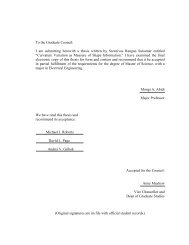Fusion of Visual and Thermal Face Recognition Techniques: A ...
Fusion of Visual and Thermal Face Recognition Techniques: A ...
Fusion of Visual and Thermal Face Recognition Techniques: A ...
Create successful ePaper yourself
Turn your PDF publications into a flip-book with our unique Google optimized e-Paper software.
Appearance-based approaches are commonly used for IR face recognition systems<br />
[36]. In contrast to visual face recognition algorithms that mostly rely on the eye location,<br />
thermal IR face recognition techniques present difficulties in locating the eyes. Initial<br />
research approaches to thermal face recognition extracts <strong>and</strong> matches thermal contours<br />
for identification. Such techniques include elemental shape matching <strong>and</strong> the Eigenface<br />
method. Elemental shape matching techniques use the elemental shape <strong>of</strong> thermal face<br />
images. Several different closed thermal contours can be observed in each face.<br />
Variations in defining the thermal slices from one image to another has the effect <strong>of</strong><br />
shrinking or enlarging the resulting shapes while keeping the centroid location <strong>and</strong> other<br />
features <strong>of</strong> the shapes constant. Perimeter, area, x <strong>and</strong> y coordinates <strong>of</strong> the centroid,<br />
minimum <strong>and</strong> maximum chord length through the centroid <strong>and</strong> between perimeter points,<br />
<strong>and</strong> st<strong>and</strong>ard deviation <strong>of</strong> that length are being considered. Automated face recognition<br />
using elemental shapes in real time has reported 96% accuracy for cooperative access<br />
control applications. A non-cooperative, non-real-time, faces-in-the-crowd version <strong>of</strong><br />
thermal face recognition achieved 98% accuracy with no false positives for more than<br />
100 people represented in a database <strong>of</strong> 500 images [37]. Yoshitomi et al [38] also<br />
proposed thermal face identification using Neural Networks. They classified based on<br />
combining various information such as gray level histograms, mosaic images, <strong>and</strong> shape<br />
factors.<br />
1.4 <strong>Fusion</strong> Approaches to <strong>Face</strong> <strong>Recognition</strong><br />
The best classifier in the world, human beings, also do not rely on a single modality<br />
to recognize objects if they are producing different information. Information fusion<br />
11
















